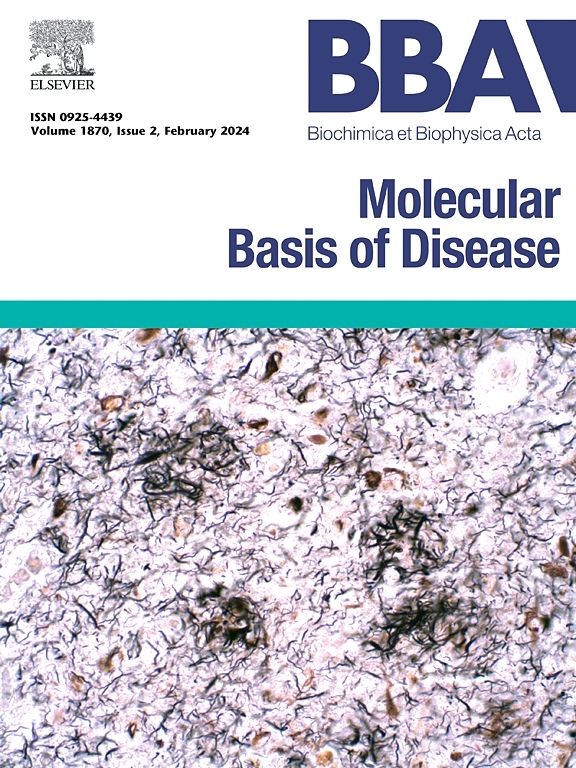Endothelial miR-34a deletion guards against aneurysm development despite endothelial dysfunction
IF 4.2
2区 生物学
Q2 BIOCHEMISTRY & MOLECULAR BIOLOGY
Biochimica et biophysica acta. Molecular basis of disease
Pub Date : 2025-03-24
DOI:10.1016/j.bbadis.2025.167812
引用次数: 0
Abstract
We previously reported a link between NRF2, a cytoprotective transcription factor, and the ageing of endothelial cells (ECs) and aorta. We also found that NRF2 KO mice are more susceptible to the development of abdominal aortic aneurysm (AAA), which is an age-associated condition. Since miR-34a is a marker of ageing, we explored its relationship with NRF2 and its role in vascular function and AAA formation.
Here, we demonstrate that premature NRF2-dependent ageing of ECs is mediated by miR-34a. Infusion of hypertensive angiotensin II (Ang II) in mice increases miR-34a in the aortic endothelial layer and serum, particularly in mice developing AAA. Mice lacking endothelial miR-34a exhibit severe EC dysfunction. Despite that, they are protected from AAA, also on the NRF2 KO background. This protective effect is reversed by rapamycin, which suppresses Ang II-induced EC proliferation. We identified MTA2, but not SIRT1, as a target of miR-34a that inhibits EC proliferation stimulated by Ang II. These findings suggest that fine-tuning of EC proliferation could have potential therapeutic implications for the treatment of aneurysms.

尽管内皮功能障碍,内皮miR-34a缺失仍可保护动脉瘤的发展
我们之前报道了NRF2(一种细胞保护性转录因子)与内皮细胞(ECs)和主动脉老化之间的联系。我们还发现NRF2 KO小鼠更容易发生腹主动脉瘤(AAA),这是一种与年龄相关的疾病。由于miR-34a是衰老的标志,我们探讨了它与NRF2的关系及其在血管功能和AAA形成中的作用。在这里,我们证明了内皮细胞依赖nrf2的过早衰老是由miR-34a介导的。在小鼠中输注高血压血管紧张素II (Ang II)会增加主动脉内皮层和血清中的miR-34a,特别是在发生AAA的小鼠中。内皮缺乏miR-34a的小鼠表现出严重的EC功能障碍。尽管如此,他们仍然受到AAA级游戏的保护,并且也是基于NRF2 KO背景。这种保护作用被雷帕霉素逆转,雷帕霉素抑制Ang ii诱导的EC增殖。我们发现MTA2,而不是SIRT1,是miR-34a抑制Ang II刺激的EC增殖的靶标。这些发现表明,微调EC增殖可能对动脉瘤的治疗有潜在的治疗意义。
本文章由计算机程序翻译,如有差异,请以英文原文为准。
求助全文
约1分钟内获得全文
求助全文
来源期刊
CiteScore
12.30
自引率
0.00%
发文量
218
审稿时长
32 days
期刊介绍:
BBA Molecular Basis of Disease addresses the biochemistry and molecular genetics of disease processes and models of human disease. This journal covers aspects of aging, cancer, metabolic-, neurological-, and immunological-based disease. Manuscripts focused on using animal models to elucidate biochemical and mechanistic insight in each of these conditions, are particularly encouraged. Manuscripts should emphasize the underlying mechanisms of disease pathways and provide novel contributions to the understanding and/or treatment of these disorders. Highly descriptive and method development submissions may be declined without full review. The submission of uninvited reviews to BBA - Molecular Basis of Disease is strongly discouraged, and any such uninvited review should be accompanied by a coverletter outlining the compelling reasons why the review should be considered.

 求助内容:
求助内容: 应助结果提醒方式:
应助结果提醒方式:


